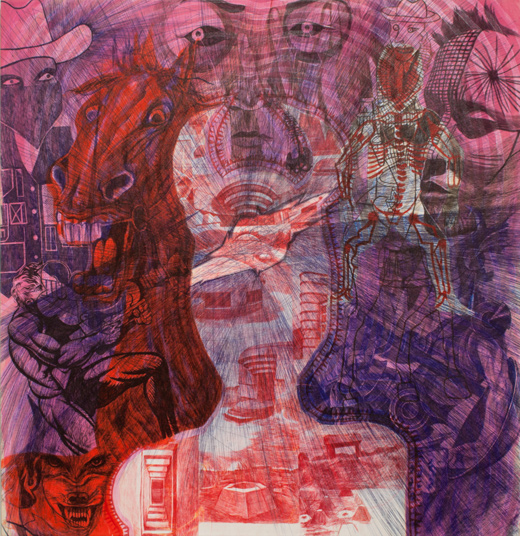RITA ACKERMANN
Hunter Braithwaite

Rita Ackermann, “World War III Around My Skull,” 1996–1997. Courtesy of MOCA, North Miami
It is not so much inverting the hierarchies of morality and aesthetic distance, moves tested by Jean Genet and Antonin Artaud, but the insistence that high and low be crumpled into a banal middle-ground. At times, the legacy of surrealist enfants terribles amounts to sophomoric shock value. Not that this inheritance is misspent; Artaud was hardly demure, having once said, “My testicles suppurated all through the night with a thick, blackish pus. Doctor Delmas said to me: ‘That’s beyond my science,’ and he added: ‘You need a gramme of heroin every day.’”
With reference points like that, its not surprising that a piece like “Firecrotch” (2008) wallows in camp. It’s not the obvious wad of symbolism that is bothersome — fire refers not to the figure’s pubic hair but to the handgun projecting from between her legs — but the feline precociousness of the eyes. They are fully formed, yet lacking, a ThunderCats stamp on Kid Pix. As a cartoon, they symbolize adolescence, and it is the processes of adolescence, not its symbols, which best hold the attention. Ackermann’s ballpoint pen drawings such as “World War III Around My Scull” (1996–1997) better capture those long stretches of fascinating boredom. Automatically, the ballpoint expands from drawing to painting, then recalls writing/record keeping and thus the passage of time. There is something masturbatory in the drawings, a closed-circuit of stifled growth. They evoke the first drafts of Our Lady of the Flowers, Jean Genet’s erotic novel that he scribbled on scraps of paper bags while incarcerated on burglary charges.
The last gallery is reserved for the “Fire by Days” (2011) series, a group of bodily paintings both unsettled and unsettling. Their relaxed volumes suggest flesh like billboard-size photographs of fetuses suggest children. Yet there isn’t bloodshed, just the natural ambivalence of red. (When viewed as diptychs, they almost suggest the dividing of the cells.) Joan Mitchell once called Helen Frankenthaler the Tampon Painter, a jab that is bizarrely relevant here. These paintings of shifting pools index menstruation, a biological process akin to birth and violence — something natural, universal, and not mentioned in polite company.










